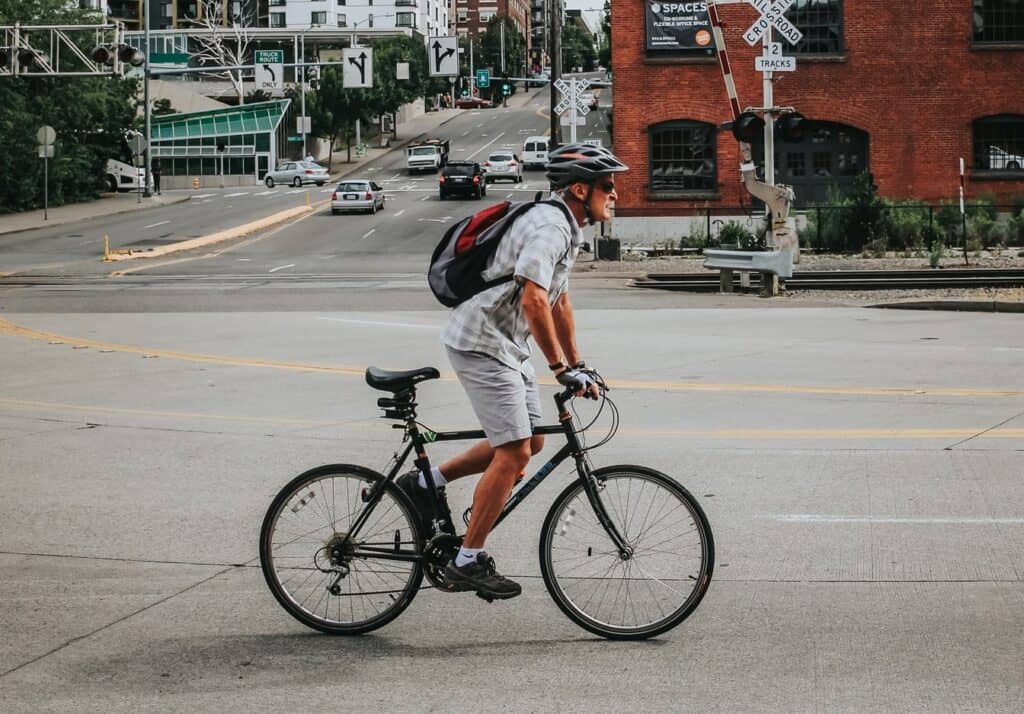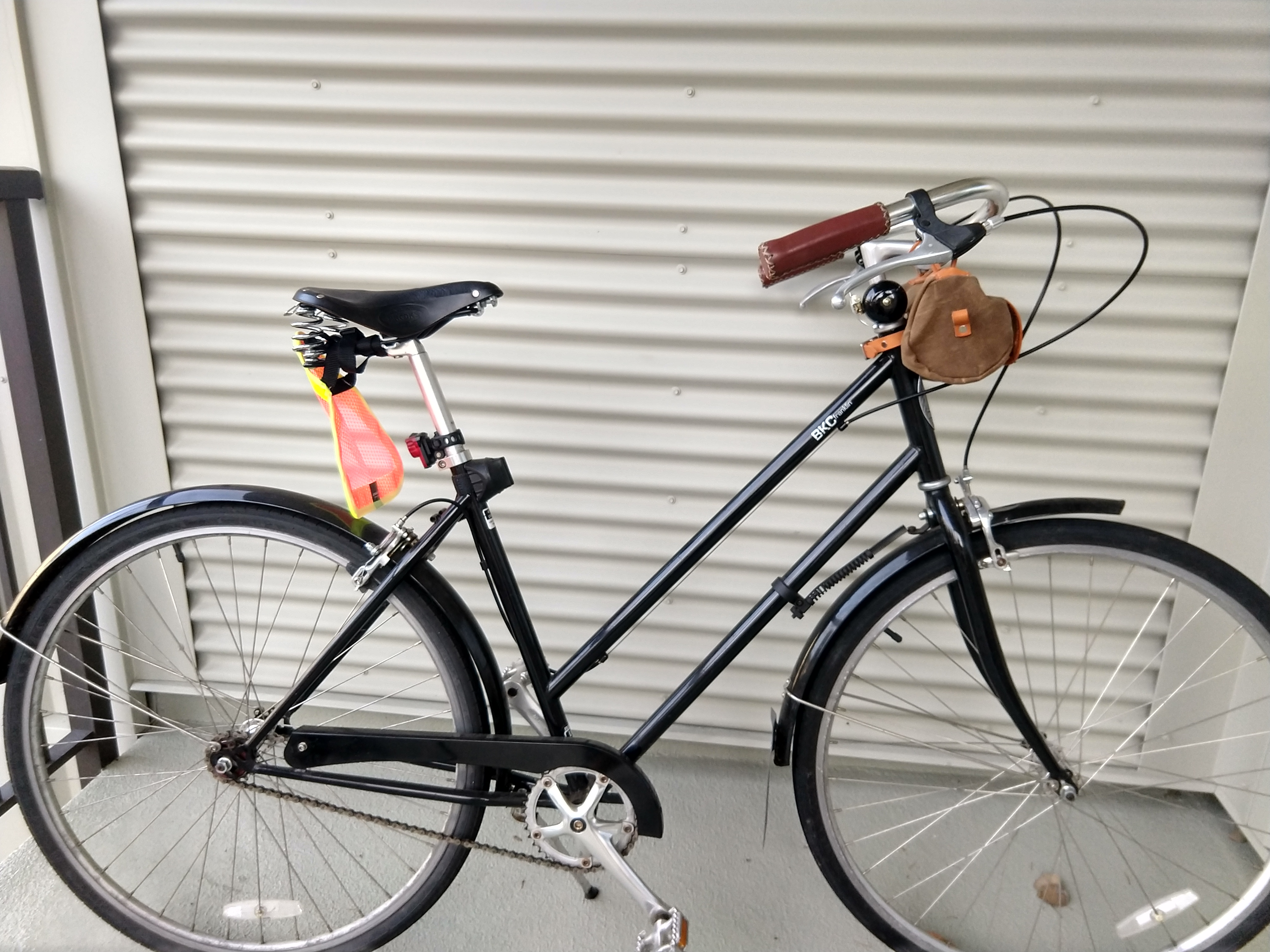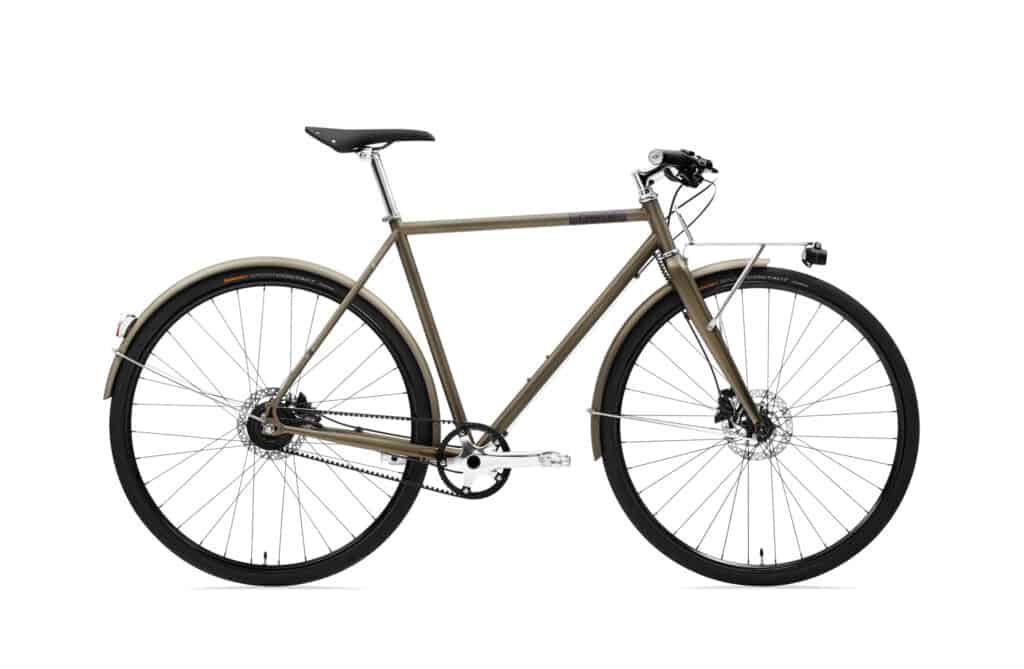Last updated: December 12th, 2022
if you’re looking for a bike for a commuting or other practical transportation, then you probably come across the “hybrid” and “city” categories quite a lot.
Terminology changes over the years and can be a little confusing. Let’s clear up the differences between hybrid vs. city bikes, then dig into some practical considerations that are worth understanding.
Here’s how city vs. hybrid bikes differ
City and hybrid bikes are different, but they overlap in use, and some brands use the label “city” for both. Traditionally, city bikes have a more upright and comfortable riding position, wider tires, and often heavier but more durable parts. Hybrids have a more forward-leaning and athletic riding position like a mountain bike, but lighter frames and parts like a road bike.
Hybrid and city bikes are both good for commuting and transportation, depending on your route and preferences.
In this article, I’ll use my experience of several years on each to highlight key similarities, differences, and pros and cons between these two popular styles.
Remember, these distinctions aren’t set in stone, and different brands may use the same labels in different. However, understanding some basic characteristics will help if you’re feeling overwhelmed by all the offerings on the market.
This article might contain affiliate links. As a member of programs including Amazon Associates, I earn from qualifying purchases.
Riding posture and comfort are the biggest differences
We need to take a brief look at riding posture, since it’s the main difference therefore the main decision factor.
At the risk of over-generalizing, upright riding posture is more comfortable but slower. Sitting bolt-upright relieves your neck, back and wrists, but increases wind exposure and limits how much you can use your glutes while pedaling. Handling will feel reassuringly stable, but perhaps not very responsive.

Forward-leaning riding posture is quicker but less comfortable. As you bend down toward the handlebars, there’s less wind resistance and you can use your glutes more. (If you notice glute pain after riding a forward-leaning bike, that’s why!)
However this can also cause neck or back strain, or place too much weight on your wrists. Handling will feel quick and precise, but possible a little less stable.
There’s a little more to it, but there’s no getting around the fundamental trade-off of efficiency versus comfort.

Why mention all this?
Well, most city bikes use upright posture to maximize comfort (and make it easier to see your surroundings). They’re intended for low to moderate speeds over low to moderate distances, often in a stop-and-go urban setting that’s teeming with traffic. In that case, top speed isn’t much of a concern.

They accomplished this through handlebars that rise higher relative to the saddle and sweep far back toward the rider. The saddle is also a little wider to support the upright position.
Of course, you can ride a city bike for as many miles as you want. It just won’t be as speedy on long rides or in stiff headwinds.
On the other hand, most hybrid bikes create somewhat forward-leaning posture to increase efficiency and make handling more precise. They’re intended for more spirited riding and perhaps longer distances, so customers like the more athletic riding position.

They do this with flat, straight handlebars like on most mountain bikes. The bars are usually positioned the same height as the saddle or even a bit lower. The saddle will be a moderate to narrow width, depending on just how aggressive the posture is.
(By the way, hybrids are often marketed as “fitness bikes,” although of course any bike can be ridden for exercise).
A quick note on hybrid vs. flat-bar road bikes
Flat-bar road bikes have become quite popular in recent years. At a glance, they’re almost identical to hybrids, and it’s hard to draw a categorical line between the two.
Compared to flat-bar road bikes, the average hybrid has a slightly sturdier frame and wheels, wider tires, less deeply forward-leaning posture, and perhaps more mounts for accessories. But the lightest and sportiest hybrids blur the line completely. That’s why I recommend deciding based on objective qualities like riding posture rather than arbitrary names and niches.
Frame materials and design often differ
Traditionally, steel is the material of choice for city bikes. It’s basically ubiquitous in the traditional European models as well as modern ones that take inspiration from them. Steel is potentially inexpensive, very resilient to knocks and bumps, and easy to repair.
However, factories these days can make high-quality, light, and very affordable aluminum frames at a large scale. As a result, aluminum is quite common for modern city bikes as well.
In my and most experienced cyclists’ opinions, high-end steel provides for a slightly smoother ride, but aluminum is perfectly decent as well. It’s worth noting that cheap steel frames tend to be significantly heavier than cheap aluminum ones without any improvement to ride quality.
But hybrid bikes draw on road and mountain bike design. Those styles are usually aluminum (to maximize stiffness and minimize weight at reasonable prices), so the vast majority of hybrids bikes also have aluminum frames.
Most city and hybrids bikes of either material still have steel forks. Steel is more supple than aluminum, so it absorbs more of the vibrations that you’d otherwise feel through the front end of the bike.
Even though carbon fiber is common for high-end road and mountain bikes, it’s not as common for hybrids—but it does exist.
Typical bikes are virtually never made of carbon fiber. It’s extremely light and great at reducing vibration, but it’s too delicate for the knocks and dings that a typical City bike endures on transit, public bike racks, and so forth.
Carbon fiber is also expensive. When a city bike is loaded up with racks, fenders, lights, and cargo or commuting gear, the weight savings make no practical difference.
Many city and hybrid bikes have surprisingly similar geometry, but when they differ, it’s usually in a couple key ways:
- Hybrids may have steeper, more aggressive head tube and seat tube angles, similar to road bikes, to improve handling in a forward-leaning posture
- City bikes have longer chainstays and longer wheelbases in general, which improve stability and keep you more centered in your upright posture (since sitting up shifts your weight back)
Hybrid bikes usually have more gears
When you’re riding around town, you’re less likely to encounter enormous hills or particularly high speeds. That’s not always true, but it’s true enough that many city bikes have limited gearing. After all, why add cost and complexity you’ll seldom need?
As few as three speeds is common if the bike uses an internally-geared hub, or IGH for short. (That’s a special type of rear hub that contains all the gears sealed off inside. It’s a bit heavy, but it replaces the more vulnerable and higher-maintenance rear derailleur.) Many IGH- and derailleur-equipped city bikes have 7 or 8 speeds, too. Some with derailleurs may go up to 27 speeds, although traditional ones do not. IGHs are nearly universal on traditional city bikes, although many modern ones have them as well.
Hybrid bikes usually have a rear derailleur, although some use an IGH with a belt drive out of necessity. (You can go here to read more about belt drive or here to see some worthwhile bikes that have them.) In any case, 7-8 speeds tends to be the bare minimum for hybrids, and many—even most—have up to 24 or 27.
However, it’s important to understand that an 8-speed IGH actually has a very similar overall gear range (ratio of highest to lower) as a 21- or 24-speed derailleur drivetrain. It just has wider steps within that overall range.
Both usually accept fenders and racks
City bikes most often include fenders since it’s assumed they will see daily use in all weather.
Hybrid bikes are typically sold without fenders, since they are often (not always) reserved for recreational or fair-weather riding.
However, nearly all hybrid bikes on the market today do have eyelets for attaching fenders. If you’re contemplating a hybrid bike for year-round riding, then make sure that the model you choose does have these eyelets, and remember to budget another $50 to $60 for fenders themselves.
It’s a similar story with racks. City bikes often (not always) include a rear rack, and practically all city bikes at least have rack mounts and extra eyelets. Hybrid bikes virtually never include rear racks, but these days, most still have the requisite mounts and eyelets, too.
(All this matter because racks are necessary for a pannier—like many commuters use—for a rear child seat, and even on their own for small items.)
Finally, city bikes often include a chainguard to protect the your pants from dirt and grease on the bicycle chain. Hybrid bikes virtually never have a chainguard, but it’s usually possible to install one aftermarket.
Wheels and tires are similar, but sturdier on city bikes
Hybrid and city bikes both feature 700c wheels most of the time, which is the same size that most road bikes use. 650b wheels have also gotten more popular as of late but are still significantly less common than 700c.
City bikes tend to have wider tires, usually 35mm at the very least. Some modern hybrids also have wide tires, but it’s still quite common to see 32mm.
Wider tires weigh slightly more and may feel just a touch slower, but they provide a smoother ride with better traction. That’s a trade-off that most urban riders are happy to make.
It’s worth noting that city bike wheels often have a few more spokes for enhanced strength. That’s not always the case, but you’re likely to see city bikes with 32 to 36 spokes as opposed to 28 to 32 spokes on hybrids. That is not a critical difference for most people, but you’ll want at least 32 spokes if you weigh 200+ pounds or carry significant cargo.
Both can be great for urban riding and bike commuting
City and hybrid bikes are both potentially good commuters since they both accept practical accessories like fenders and racks.
Riders with stop-and-go urban commutes typically favor city bikes. Riding fast isn’t much of an option—at least not for longer than a block or two at a time—so opting for comfort and smoothness makes sense.
Riders who take a slightly more athletic approach to their commute often prefer hybrids over city bikes. They appreciate the efficiency when riding at higher speed. With a modest commuter load (like a laptop, lunch, and clothing) snugly in a pannier, most hybrids will still handle perfectly well.
Neither is good for rugged off-road riding
Hybrids and city bikes are both perfectly capable of smooth dirt roads and gravel paths, but they’re almost never strong enough to withstand the impact of rough, off-road terrain.
To be clear, they’re not made of glass. You don’t need to worry about hopping up or down a curb on occasion. And they’ll certainly take much more of the beating than an ultralight carbon fiber racing bike. The point is simply that if rugged riding is your goal, then you’re better off with a proper mountain bike.
Another consideration is that hybrids and city bikes tend to have low bottom brackets in order to lower the center of gravity and improve handling non-smooth terrain. That’s perfect for this city, but it’s a problem when you’re trying to roll over rocks and roots that your chainrings can’t quite clear.
Finally, and more specific to city bikes, an upright riding position can feel sketchy on very steep off-road terrain. Typical city bike posture and handlebars just don’t leave room to lean forward and back on steep pitches.
Since many hybrids look like mountain bikes, you might guess they’re suited to gnarly singletrack. Unfortunately, that’s not quite the case. Hybrid and MTBs differences are significant, so hybrids are about as capable off-road as are city bikes—which is to say, not highly.
Should you buy a city or hybrid bike?
Between the two, city bikes are optimal for shorter distances, moderate speeds, and altogether more relaxed urban riding. They’re not inherently slow; they’re just not optimized for fast riding.
Here’s how to choose a city bike one you’ll love.
Hybrids are optimal for riders who don’t mind sacrificing a little comfort to ride generally faster, especially over more long and open commutes with less stop-and-go. To be clear, hybrid bikes are not uncomfortable. They just sacrifice the perfect comfort of upright riding for a more efficient pedaling and precise handling.
Here are some of the best hybrids on a budget, to get you started.
If at all possible, try to test both a city and a hybrid bike in person. I hope this overview is helpful, but the feeling of actually riding each one is hard to fully capture in words.
If you’re not sure buying a new bike makes sense at this point, then there’s no need to spend money just yet. A few key accessories can turn almost any reasonable bike into a practical, useful one. Read this guide to learn what and how.
After riding a ridiculous number of bikes for commuting and other practical purposes, I remain delighted with the Brooklyn Bicycles Franklin. It’s neither a sporty hybrid nor a totally relaxed city bike, but hits a happy medium that I think most everyday riders will appreciate. Read the review here for more details.
